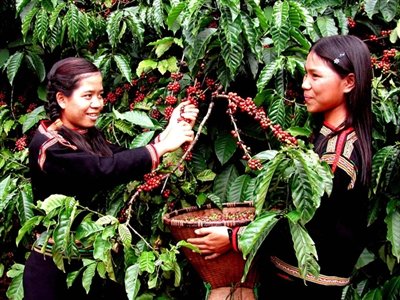VietNamNet Bridge – While the local authorities and farmers have to spend
hundreds of trillions of dong to develop the material growing areas and improve
old and stunted coffee trees, foreign enterprises just have to wait and get the
upper hand of the material sources.
Vietnamese coffee brands trembling amid the foreign storm
 |
|
|
One of the easiest method foreigners have been applying to dodge the laws is carrying out the projects on supporting farmers to develop material areas.
In May 2012, the project on building up a wet coffee processing system in Dak Lak was introduced by the M4P2 project’s consultancy team to local farmers. The first beneficiaries from the project were the 53 households in Cu M’gar district, who were the members of the Ea Kiet cooperative.
The households then received the fair trade certificates and together managed a wet Robusta processing system worth six billion dong built up and transferred by Dakman.
According to Nguyen Van Phuc, a cooperative member--said that with the granted certificate, the coffee with Ea Kiet brand, grown on the basalt fertile land in Dak Lak province, would be collected by Dakman at high prices, about 2.2-2.5 million dong per ton higher than the average market prices. As such, every household can earn 15-20 million dong more a year.
It is expected that hundreds of households more would join the project, which means that the material growing area would be expanded. And of course, the coffee beans would be sold to Dakman, the priority buyer. This spells that domestic enterprises would find it hard to squeeze into the area to collect coffee materials.
As such, with a modest sum of money, the foreign enterprise now can penetrate the material areas, easily dodging the Decree 23 with its strict regulations.
At the World Economic Forum East Asia - Pacific held in HCM city in 2010, the Ministry of Agriculture and Rural Development committed to join forces with 12 international enterprises to set up five private public partnership (PPP) groups for many kinds of farm produce, including coffee.
At the World Economic Forum held in Davos, Switzerland in January 2011, 17 international companies, including Nestle, Yara, Syngenta, Cisco, EDE Consultang and Dakman put forward the PPP initiative called “the new vision.”
Under the initiative, Nestle Vietnam alone, through the sustainable agricultural production models, has set up the goal of collecting ¼ of the total Robusta annual output.
The move by Nestle has trembled Vietnamese enterprises. It’s clear that in the game between the foreign “big guys” with the turnover of billions of dollars and the weak domestic producers, the foreigners are always in the upper hand.
How to re-arrange the chessmen on the coffee chessboard
Thai Hoa Group, a well-known coffee producer in Vietnam, has discontinued the construction of the soluble coffee processing plant which has the designed capacity of 180,000 tons per annum. Thai Hoa, which was eager to join the unequal competition with foreign invested enterprises (FIEs), has suffered utter defeat.
The coffee output in Lam Dong province, about 350,000 tons a year, has been mostly gathered to the “gigantic bag”, called “FIEs”, not to the Thai Hoa’s bag. Foreign enterprises can borrow dollar loans at the low interest rates of 3.5-4.5 percent per annum. Meanwhile, Thai Hoa, like other domestic businesses, have to bear the interest rates 4-5 times higher.
Analysts have said Vietnam now has only several powerful chessmen left, namely Intimex Group, No. 1, which plans to export 200,000 tons of coffee in the 2011-2012 crop.
The No. 2 is Simexco Dak Lak, which plans to export 110,000 tons, while the third one is Tin Nghia Dong Nai Corporation, 90-95,000 tons.
They are the enterprises, which prepared themselves well before the admission to WTO. They are prestigious enough to be able to sell coffee directly to the international coffee roasters at the best prices. Especially, they can also borrow dollars from foreign banks at reasonable interest rates.
Source: Tien phong